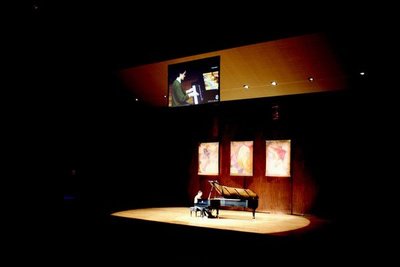November 10, 2010
Show of hands: New screens in Meany Hall will show pianists’ hand movements up close
The acoustics of Meany Hall are splendid, so when musicians play, the audience hears everything beautifully. But sight lines can be a more difficult matter — especially when a pianist performs.
Problem solved. New video screens recently installed at Meany will give audiences an up-close look at the pianists’ fingering as they play. They’ll make their debut the evening of Wednesday, Dec. 1, when pianist Lara Downs makes her debut at the President’s Piano Series, presented by the UW World Series. (Learn more about that concert here).
“The acoustics at Meany are world class. There’s an intimacy — for a 1,200-seat theater, the design really provides an intimate relationship between every person in the house and the stage,” said Matthew Krashan, director of the UW World Series, who has a background in stage design. “It’s a warm, natural sound that carries throughout the house.”
Krashan said he often sits in the upper-right balcony, because it’s a seat he can get to after a performance starts without disturbing others. And while he can hear perfectly back there, “You really can’t see the pianist’s hands — so having that screen is going to be great for me. I’m looking forward to it.”
Krashan said the new system will enhance the visual experience to match the great sound without getting in the way of the performance. “This system is state of the art high-definition. And you do not actually have to watch the screen — that’s the great part. You can simply focus on the performer if you want, and close your eyes and listen. The screen is no imposition on either the audience or the performers.”
As a pianist, music professor Robin McCabe likes the idea: “I think this is really a very nice enhancement, and I’m glad they’re doing it. We do associate music with movement, and that goes all the way back to the dance. And really, we do like to see how this great sound is produced — how people move, or their economy of movement.”
McCabe said there’s something “almost primitive” in watching the dexterity of a trained pianist. “You can’t take away the fact that performance has an element of sport to it. Like a backhand of Roger Federer.”
She said it’s interesting how styles change though the ages. “The first piano recitals were played with the pianist’s back to the audience.”
Then along came Johann Dussek (1760-1812), McCabe said, “who thought he was so handsome he turned his profile to the audience and turned his piano sideways. He was the first fellow to do it. The audience was absolutely enthralled, and ever after we pianists have been turning our profiles to the audience.”
Krashan said all pianists who play Meany Hall will, of course, have consented to participating with the new technology.
For a run-through of the system, Krashan looked up yet another well-known UW pianist: “Craig Sheppard was kind enough to volunteer to help us test the process,” he said. “Craig played the piano on stage as we tested the system, and it was no distraction.”
Krashan added, “I am really hoping this will be of assistance to audiences as we try to carry on a pretty incredible 30-year tradition.”



